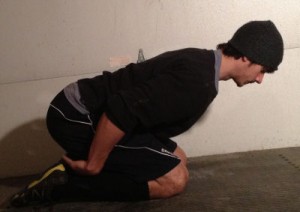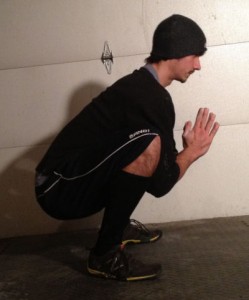So you can’t squat deep, I get it. Back in 2005 I asked my then mentor how to better my squat. (Hello Chicanerous.) I sent him a video of myself descending slowly to an unstable bottom position, and rising just as unsure of myself. It probably took ten seconds to complete one repetition. His advice: squat like you mean [...]
 So you can’t squat deep, I get it. Back in 2005 I asked my then mentor how to better my squat. (Hello Chicanerous.) I sent him a video of myself descending slowly to an unstable bottom position, and rising just as unsure of myself. It probably took ten seconds to complete one repetition. His advice: squat like you mean it, put some effort behind it, and have confidence.
So you can’t squat deep, I get it. Back in 2005 I asked my then mentor how to better my squat. (Hello Chicanerous.) I sent him a video of myself descending slowly to an unstable bottom position, and rising just as unsure of myself. It probably took ten seconds to complete one repetition. His advice: squat like you mean it, put some effort behind it, and have confidence.
For the next few years I did just that. But the bottom position was always foreign to me. So I did the myriad of mobility exercises and flexibility work. But in all my years, nothing helped me more than “making room” and simply squatting.
SQUAT TIP #1: MAKE ROOM
Get on your knees, push your hips back, and collapse on your thighs. It’s similar to a position in my article, Learn How to Hinge in 3 Easy Steps that appeared on Elite FTS. Lazily hang out here for a little while for a nice stretch.
But to get serious, settle your lower back into a neutral position and contract your hip flexors. Try smashing your thighs into your chest. Of course, they won’t budge, but your goal is to activate the muscle, not actually move.
If you flipped yourself ninety degrees, this position resembles the bottom of a squat. And it helps those that lose their back position with depth, specifically when their thighs are nearing contact with their upper body.
Contract for thirty seconds or so. Nothing extreme. If you want, do a contract-relax thing, or pulsed muscle contractions. I’m not picky as long as you’re putting in the work. This works best before a squat workout, or in between sets. To transfer it better, cue yourself to contract your hip flexors on the descent of your squat.
SQUAT TIP #2: SQUAT OFTEN
Somewhere along the line we get brainwashed into thinking that exercise without a barbell is useless. But if the only time we squat deep is when there’s a barbell on our back, we have problems.
The best way to cure your squatting woes is to squat often, without a barbell. If you have trouble hanging out in the bottom position of an unweighted squat, it’s no wonder you can’t do it with a barbell on your back.
The deep squat position itself cures all mobility concerns. The most common complain will be, “My shins are burning.” Good. Make this position familiar to your being. If you have to spend an hour doing warm-ups and mobilizations before you can squat deep, you’re amiss.
I like hanging out in squat position every morning for thirty seconds or so. On top of that, before every workout (upper body included, and most rest days even), I do thirty body weight squat repetitions. Make sure you descend in between your legs, not on top of them. Take a look at the picture at the top of the page to see what I mean.
When I look back on Chicanerous’s advice, it was difficult to implement because the squat position was unfamiliar. I was afraid of it because I had chronic knee pain. But now I do duck squat walks and other deep squat mobilizations. My squats and my knees have never felt better. So get down there, work the kinks out every day, and just become more familiar with the position.
THE 20 REP SQUAT EXPERIMENT
Since I’m talking squatting, I’ll share this news:
I shattered my foot back in January of 2011. Shame on you if you didn’t know that by now as I cry about it every chance I get. Recently, I squatted 315×5. Nothing crazy. But I’m proud of it considering I have pinching nerve pains in my foot at times.
This nerve pain is why, at this point in my life, I don’t care to have more than 315 on my back. So it’s a perfect time to give 20 rep squats a go. Inspired by Dan John and his Mass Made simple program, the program I am running consists of basic strength movements, high rep squats, and barbell complexes—with my own unique twists of course (tumbling and gymnastics).
For the next ten weeks (two week break in period, eight week program) I’m undergoing this experiment. Twenty rep squats have been around for a while and are fabled. Credible people pose compliments to complexes too.
Finally, you literally need to spend more time on the bar. No, I didn’t say “at the bar.” Bourbon and squats don’t mix. I’ve tried that workout. Trust me on this. No, the single best way I know to get more time with a bar in your hands is to use complexes.
-Dan John
“I believe if you can take a light weight—sometimes even your bodyweight—and pour all of your energy into five exercises for a total of 100 seconds that you’ll hit more motor units than you would even touch with a regular weight-training session…”
– Martin Rooney
Usually the athletes lift barbells and then immediately drop them. This takes several seconds. According to Alexeyev’s method, the sportsman finds himself under the weight for a period of two or three minutes. The entire body must sustain this prolonged effort, as the athlete completes several consecutive exercises without letting go of the equipment. The weight of the barbell is relatively light, but the varied work with it affects every muscle cell.
By the end of the two-week session, all Alexeyev’s students had increased their bodyweights as a result of muscle growth and at the same time they’d increased their abilities. Here is what Sultan Rachmanov said: “At first I trained in my own way. I didn’t believe that Alexeyev’s advice would help me. Now I believe … My shoulders, my back, everything is filling up with strength.
My goal is to get jacked. That is all. But I’m an athlete at heart so, of course, I’m going include feats of explosiveness and see how this kind of programming affects my vertical jump. In the best case, I’ll come out on with some cool data and training suggestions for my skinny fat ectomorph brethren.
Now, I was seeing great progress on the program I was on. But what’s life without experimentation? I’m going to be keeping daily track of nearly everything—bodyweight, reaction time, mood, feelings, sleep, food—through pictures and videos and compiling it into a PDF.
My Twitter account is going to be a update station. Tweets will be hashtagged with “#20REPEXP.” So if you follow me now, get annoyed by it, and unfollow me, then oops. But if you want to tag along, I’d love to have you as a follower. The only other place I’ll update my training is on the Precision Nutrition Members Forum.
I hate high repetition training. So this should be fun. Real fun.


